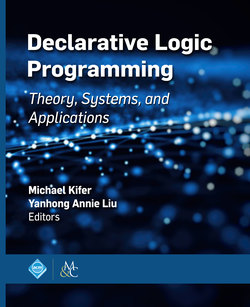Читать книгу Declarative Logic Programming - Michael Kifer - Страница 7
На сайте Литреса книга снята с продажи.
ОглавлениеContents
Preface
PART I THEORY
Chapter 1 Datalog: Concepts, History, and Outlook
David Maier, K. Tuncay Tekle, Michael Kifer, David S. Warren
1.1 Introduction
1.2 The Emergence of Datalog
1.3 Coining “Datalog”
1.4 Extensions to Datalog
1.5 Evaluation Techniques
1.6 Early Datalog and Deductive Database Systems
1.7 The Decline and Resurgence of Datalog
1.8 Current Systems and Comparison
1.9 Conclusions
Acknowledgments
References
Chapter 2 An Introduction to the Stable and Well-Founded Semantics of Logic Programs
Miroslaw Truszczynski
2.1 Introduction
2.2 Terminology, Notation, and Other Preliminaries
2.3 The Case of Horn Logic Programs
2.4 Moving Beyond Horn Programs—An Informal Introduction
2.5 The Stable Model Semantics
2.6 The Well-Founded Model Semantics
2.7 Concluding Remarks
Acknowledgments
References
Chapter 3 A Survey of Probabilistic Logic Programming
Fabrizio Riguzzi, Theresa Swift
3.1 Introduction
3.2 Languages with the Distribution Semantics
3.3 Defining the Distribution Semantics
3.4 Other Semantics for Probabilistic Logics
3.5 Probabilistic Logic Programs and Bayesian Networks
3.6 Inferencing in Probabilistic Logic Programs
3.7 Discussion
Acknowledgments
References
PART II SYSTEMS
Chapter 4 WAM for Everyone: A Virtual Machine for Logic Programming
David S. Warren
4.1 Introduction
4.2 The Run-Time Environment of a Traditional Procedural Language
4.3 Deterministic Datalog
4.4 Deterministic Prolog
4.5 Nondeterministic Prolog
4.6 Last Call Optimization
4.7 Indexing
4.8 Environment Trimming
4.9 Features Required for Full Prolog
4.10 WAM Extensions for Tabling
4.11 Concluding Remarks
Acknowledgments
References
Chapter 5 Predicate Logic as a Modeling Language: The IDP System
Broes De Cat, Bart Bogaerts, Maurice Bruynooghe, Gerda Janssens, Marc Denecker
5.1 Introduction
5.2 FO(ID, AGG, PF, T), the Formal Base Language
5.3 IDP as a Knowledge Base System
5.4 The IDP Language
5.5 Advanced Features
5.6 Under the Hood
5.7 In Practice
5.8 Related Work
5.9 Conclusion
References
Chapter 6 SolverBlox: Algebraic Modeling in Datalog
Conrado Borraz-Sánchez, Diego Klabjan, Emir Pasalic, Molham Aref
6.1 Introduction
6.2 Datalog
6.3 LogicBlox and LogiQL
6.4 Mathematical Programming with LogiQL
6.5 The Traveling Salesman Problem (TSP) Test Case
6.6 Conclusions and Future Work
References
PART III APPLICATIONS
Chapter 7 Exploring Life: Answer Set Programming in Bioinformatics
Alessandro Dal Palù, Agostino Dovier, Andrea Formisano, Enrico Pontelli
7.1 Introduction
7.2 Biology in a Nutshell
7.3 Answer Set Programming in a Nutshell
7.4 Phylogenetics
7.5 Haplotype Inference
7.6 RNA Secondary Structure Prediction
7.7 Protein Structure Prediction
7.8 Systems Biology
7.9 Other Logic Programming Approaches
7.10 Conclusions
Acknowledgments
References
Chapter 8 State-Space Search with Tabled Logic Programs
C. R. Ramakrishnan
8.1 Introduction
8.2 Finite-State Model Checking
8.3 Infinite-State Model Checking
8.4 Simple Planning via Tabled Search
8.5 Discussion
Acknowledgments
References
Chapter 9 Natural Language Processing with (Tabled and Constraint) Logic Programming
Henning Christiansen, Verónica Dahl
9.1 Introduction
9.2 Tabling, LP, and NLP
9.3 Tabled Logic Programming and Definite Clause Grammars
9.4 Using Extra Arguments for Linguistic Information
9.5 Assumption Grammars: DCGs Plus Global Memory
9.6 Constraint Handling Rules and Their Application to Language Processing
9.7 Hypothetical Reasoning with CHR and Prolog: Hyprolog
9.8 A Note on the Usefulness of Probabilistic Logic Programming for Language Processing
9.9 Conclusion
References
Chapter 10 Logic Programming Applications: What Are the Abstractions and Implementations?
Yanhong A. Liu
10.1 Introduction
10.2 Logic Language Abstractions
10.3 Join and Database-Style Queries
10.4 Recursion and Inductive Analysis
10.5 Constraint and Combinatorial Search
10.6 Further Extensions, Applications, and Discussion
10.7 Related Literature and Future Work
Acknowledgments
References
Index
Biographies
